Buddha Room Paintings – The 12 Stages of Buddha’s Life
PRIMITIVE - Friday, November 25, 2016By Glen Joffe
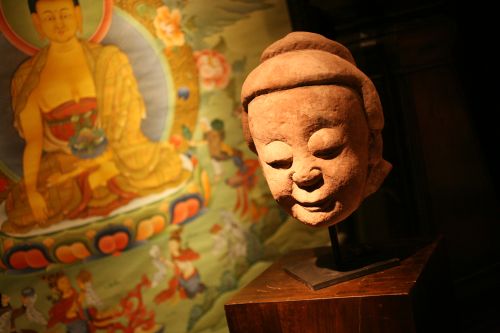 |
|
In the scheme of things very few people are remembered long after they live, especially those who lived before humankind became industrialized and modern media made the historical record more exact. These days, what a person said or did decades before can be regurgitated in agonizing detail if it’s unflattering and in joyous celebration if it’s the opposite. Yet, even with modern media, it is still difficult to be remembered by succeeding generations. It seems time has a way of making our imprints fade. Now, travel back 2,500 years ago, long before there were newspapers, television, DVD’s, the internet, radio, and any other media for that matter, and can you name a historical figure from that time? If you can, it’s likely that person’s name is Gautama Siddhartha, also known as Buddha.
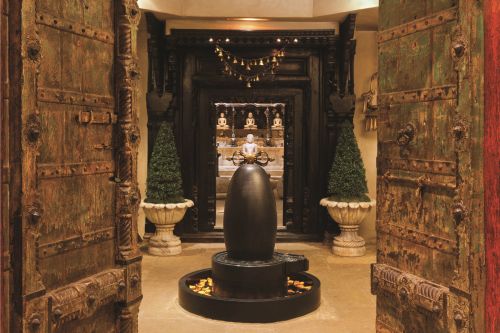 |
|
In the 2,500 years since the historical Buddha lived, his story has been told countless times and his teachings became the basis for one of the world’s great religions – Buddhism. Although there is general agreement among historians that Buddha was an actual person, the actual times of his birth and death are uncertain as are many details of his life. There are simply too many conflicting sources. In the age of Alzheimer’s it’s easy to ask, “how can you remember what happened 2,500 years ago, when you can’t remember what happened 25 minutes ago?” Yet, in the case of Buddha, time actually magnified his imprint even though specific details of his life and speeches may remain sketchy. The first full biography of Buddha, the Buddhacarita, an epic poem written by the Indian philosopher Asvaghosa, appeared during the first century CE, approximately 500 years after Buddha’s death. The next oldest biography, the Lalitavistara Sutra, didn’t appear until the 3rd century CE, another 200 years later. Nonetheless, there is wide acceptance on the general sequence of Buddha’s life, which may be described as birth, upbringing, renunciation, liberation and enlightenment, teaching and death. Add in all sorts of embellishments from poets, philosophers, mythologists, authors and historians; and Buddha’s story can be extended to 12 distinct stages – also known as the 12 Deeds. The 12 Deeds are:
1) Descent from Tushita heaven; 2) Entering the Mother’s womb; 3) Taking birth; 4) Accomplishment in Worldly Arts; 5) Marriage and the Four Excursions; 6) Renunciation; 7) Life as an Ascetic; 8) Enlightenment Under the Bodhi Tree; 9) The conquest of Evils; 10) Attainment of Buddhahood; 11) Promulgating the Teachings; and 12) Entering Nirvana.
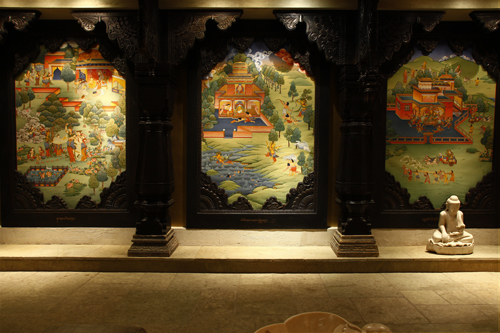 |
|
In 2006 the Buddha Room opened at PRIMITIVE. The Buddha Room is meant to be an adaptation – not a recreation - of a Himalayan temple. Originally six of fourteen solid teak pillars in the room were acquired in Ahmadabad, India. The remaining eight pillars were carved along with their stone footings and the wings on top of the pillars. Along with these architectural elements, twelve frames were then carved to line the walls between the pillars; and in turn, a well known monastery painter in Nepal by the name of Mohan Lama was commissioned to create a series of murals depicting the 12 stages of Buddha's life. The paintings were executed on canvas as large scale Thangka paintings. Thangkas are Tibetan Buddhhist paintings usually executed on cotton or silk. Traditionally, they are kept unframed, rolled up when not on display, and backed with silk. Thangkas usually depict Buddhhist deities and scenes from the life of Buddha although they may also illustrate other concepts. The Buddha Room paintings are clearly meant to be displayed all the time and they are not backed, but instead, laid up on wood boards. They were painted using stone ground colors, acrylic paint and gold. Also, no mechanical devices were used in their creation; only human hair brushes. The following are more detailed explanations of the paintings:
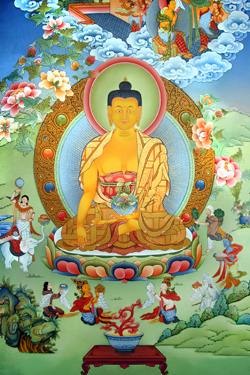 |
|
Panel One; Descent from Tushita Heaven: in Buddhism there are multiple heavenly realms. Like other realms, Tushita can be reached through meditation. It is the realm where Gautama Siddhartha resided as a fully realized Buddha before coming to earth. It is also the realm where Maitreya, the future Buddha resides. It is the place where all Bhoddisattvas dwell before coming to earth to reach full enlightenment. In panel one; Buddha is depicted as a fully realized being. In his hand is an alms bowl containing the “Three Jewels,” the ideals at the heart of Buddhism. The three jewels are: 1) the ideal of Buddhahood itself, a place of attainment (the yellow jewel); 2) mastery of the Dharma or the teachings of Buddha (the blue jewel); and 3) fellowship among the Sangha or the community of devotees (the red jewel). In addition to the Three Jewels, panel one’s depiction of Buddha shows him with a mudra, or hand position, called Bhumisparsa. Generally speaking, mudras refer to hand positions that have different meanings. In the Bhumisparsa mudra, the right hand of Buddha is seen as pendant over the right knee reaching toward the ground with the palm inward. This is called the earth touching gesture. His left hand is shown with the palm upright in his lap. This gesture represents the exact moment of the Buddha’s awakening. Taken together, the two hand positions reflect the sentiment that Buddha is calling the earth to witness his awakening at the exact moment of his enlightenment. It is in Panel One that Buddha makes a conscious decision to come to earth to help relieve humankind of all suffering. Also notable in panel one is the appearance of the white elephant, which plays a significant role in panel two, Entering the Mother’s Womb.
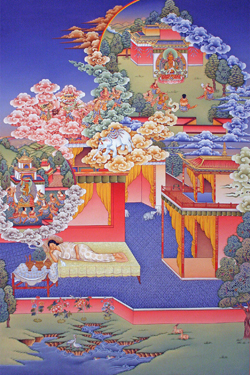 |
|
Panel Two; Entering the Mother’s Womb: Panel Two is a reference to Buddha’s conception. Here one begins to see comparisons between Catholicism and Buddhism, specifically to the Immaculate Conception. Mythology states, Buddha’s mother, known as Mahadevi, dreamed a white elephant descended from heaven to enter her womb, which it did, entering from her right side. The white elephant reflected the idea of a pure and powerful being. Panel Two shows the white elephant descending toward Mahadevi. It is also important to note that Buddha was raised as a Hindu and Mahadevi in Sanskrit and Hinduism is known as the Great Goddess. She is considered an all-encompassing deity, the supreme force creating the soul of the universe. It is only fitting, mythologically speaking, that Buddha was born to another supreme power, in this case a female goddess. The symbolism of Panel Two is hard to ignore. Buddha chose as his mother an individual who stood at the heart of the universe itself, the heart of physical existence, an individual who represented the source of abundance, knowledge, peace, faith, fortitude, knowledge, humility, modesty and mercy. That is the essence of Mahadevi, the deity from whom all other female deities spring. It is fitting that she is Buddha’s mother; yet, if Buddha is truly a historical person, then was his real mother a goddess? These are the tricks mythology plays. Let’s just say Panel Two illustrates the Buddhist version of the Immaculate Conception, and reality would have a difficult time conforming to mythology. That said, one interpretation of Panel Two is it represents the ideal of divine conception – the birth of universal concepts elevating the human experience to the divine.
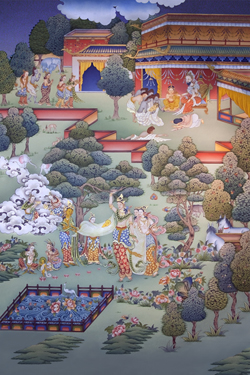 |
|
Panel Three; Taking Birth: According to Buddhist legend, Mahadevi, Buddha’s mother, was married to Suddhodana, a king of the Shakya clan. As was the Shakya tradition, when Mahadevi became pregnant she went to live with her father to give birth; however, along the way she gave birth to her son while standing upright, in Lumbini in present day Nepal under a Sal tree, a plant native to the Himalyas and the Indian sub-continent. Many sources say his mother died during birth; some say seven days later. Panel Three illustrates the birth of Buddha in the reverse of the way he entered his mother’s womb. In other words, he was born from her right side. The panel also shows the divine nature of Buddha, for with each step he took after birth a lotus flower appeared. Panel Three also references another story surrounding Buddha’s birth. When the infant was brought to his father the prince was formally named Gautama Siddhartha; Gautama being the family name. During celebrations over the child’s birth the king was visited by a seer as well as Brahmin scholars. All the predictions regarding the infant’s life suggested he would become a great king or a great holy man. Panel Three shows this taking place in front of the king in the upper portion of the panel.
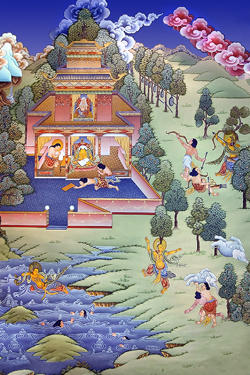 |
|
Panel Four; Accomplishment in Worldly Arts: Panel Four extends the story of Buddha’s life by referencing directly the circumstances of his upbringing, most notably that he was a prince. His father was said to have shielded him from all human suffering and even from religious teachings as he wanted his son to ultimately become a king rather than a sage or holy man. As Siddhartha grew up he was exposed to the traditional arts and sciences as well as sports such as wrestling and archery. Panel Four illustrates Siddhartha swimming, wrestling, performing feats of archery, and writing poetry. This panel also shows that the young prince was afforded a sheltered life. Equally important to note is that Buddhist scripture suggests even at an early age Siddhartha felt the pursuit of material goods alone was not the ultimate purpose of life.
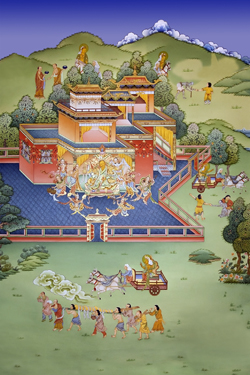 |
|
Panel Five; Marriage and the Four Excursions: There is general agreement regarding the events depicted in Panel Five, but differences in opinion regarding the sequence. Panel Five illustrates Siddhartha was married through an arranged marriage to his cousin at the age of 16, a story widely told in Buddhist history and mythology. He then left the family compound and was exposed to human suffering and pain for the first time. On these excursions he saw death, old age, infirmity, and devout ascetics. In the center of Panel Five is a depiction of Siddhartha’s marriage celebration, and starting from the bottom and running counter clockwise depictions of the four excursions. The young Siddhartha is shown riding in carts and on horseback. Some texts suggest Prince Siddhartha left the family compound multiple times before his marriage; and in fact, his marriage was arranged by his father out of fear that his son would leave permanently to pursue a monastic life. Either way, he ultimately left and embarked on his journey, a scene illustrated in the next panel, called Renunciation.
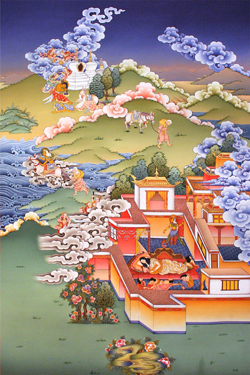 |
|
Panel Six; Renunciation: Panel Six shows Gautama Siddhartha leaving his wife and children to lead the life of a wandering ascetic and thinker. It is generally accepted this occurred at the age of 29. On the left hand side of the painting you can see Siddhartha leaving his privileged life and toward the top his clothes being returned. In Buddhist mythology, the encounters Siddhartha had with people on his excursions deeply imprinted his mind with images of suffering, sickness, ageing and death. He also understood reincarnation and therefore intuitively knew the key to enlightenment was liberation from this endless cycle of birth and rebirth – the cycle of suffering – known as Samsara. Mythology states that at the time of his departure he was accompanied by his charioteer, a man named Channa. It was Channa who first accompanied the prince on his excursions outside the royal compound. In Panel Six, Gautama Siddhartha is shown leaving atop his favorite steed, Channa’s horse Kanthaka with Channa following behind. In turn, it is Channa seen leading Kanthaka back to the palace with Siddhartha’s belongings so he will be free to lead an ascetic life, which is illustrated in Panel Seven, entitled Life as an Ascetic.
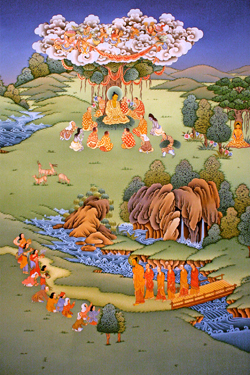 |
|
Panel Seven; Life as an Ascetic: Panel Seven, like all the other panels in the Buddha Room, reflect stories within stories. In this panel the central theme is illustrated on the right hand side, where Buddha is shown in a trance meditation withering away under a tree. From the time Siddhartha left home at 29 until the age of 35 he practiced an extreme ascetic life. It was said that he consumed as little as a few seeds a day or even just one leaf. Ultimately, he became emaciated or skeletal. Images of Buddha like this are often referred to as the Skeleton Buddha or Emaciated Buddha. When Siddhartha embarked upon his ascetic life, he was accompanied by a group of five companions who together with him practiced severe austerities. Collectively, they engaged in self-mortification, depriving themselves almost entirely of food as a means of seeking enlightenment. Siddhartha was able to achieve such a high level of austerity that the others soon followed him in his pursuit. In Panel Seven they are shown following Siddhartha as they cross a bridge, mendicants approaching a group of devotees recognizing and honoring their spiritual quest. It is commonly said, one day Siddhartha collapsed in a river after nearly starving himself to death. He was saved by a village girl named Sujata who fed him some porridge. It was this event, his resuscitation with food after practicing such extreme austerities that caused Siddhartha to reevaluate the ascetic life as a path that did not work. Ultimately, he realized the meditative path was correct and established what Buddhists commonly refer to as the Middle Way, which says one should not lead an overly indulgent life and meditation is the key to enlightenment and liberation. Upon the adoption of this path, his five followers abandoned him to continue with their devotion to austerity. Siddartha began preaching the Middle Way, which is depicted at the top of the panel. It is worth noting that a man carrying wheat to make bread is shown walking by Siddhartha’s new followers as celestial angels above rejoice the unfolding of the Middle Way. At this point in the story, technically speaking Siddhartha is still not Buddha. There is still work to do, and this is illustrated in Panel Eight, Enlightenment Under the Bodhi Tree.
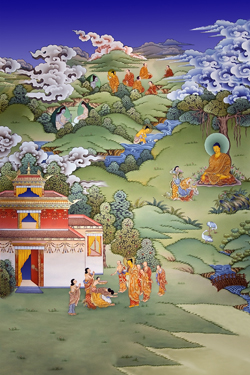 |
|
Panel Eight; Enlightenment Under the Bodhi Tree: The earliest Buddhist texts suggest that after Siddhartha discovered the Middle Way, and after he had regained his strength, he vowed to enter a meditative state and never to arise until he had discovered the ultimate truth about how to fully end mankind’s suffering. He made his way to a place named Bodh Gaya in India and found a spot perfect for his meditation. The bottom of Panel Eight shows Siddhartha on his way to Bodh Gaya being honored as a sage and holy man. In Bodh Gaya, seated under a Bodhi Tree he entered meditation and remained there until his awakening, some 45 days later at the age of 35. Panel Eight on the right hand side illustrates Siddhartha in meditative posture under the Bodhi Tree, which is also known as the Pipal Tree. When he awoke, he had achieved a complete state of liberation and enlightenment, but Panel Eight does not illustrate a fully awake person who has attained Buddhahood. This full awakening does not occur until Panel Ten. When Siddhartha embarked upon his mediation under the Bodhi Tree, it is said he realized he was very near to full enlightenment. In this meditation he focused on the Dharmakaya, considered the true basis of all reality and the place, space or mind from which all phenomenon spring. It is also called the true nature of Buddha and Buddhahood. As he was engaged in this meditation other Sadhus (holy people) and followers discussed his meditative pursuit, and this is shown at the top of Panel Eight. It was during this meditation that Siddhartha encountered the Demon Mara, the fiercest demon in the world, who tried to lure him away from his full concentration on the Dharmakaya, and this is illustrated in Panel Nine; The Conquest of Evils.
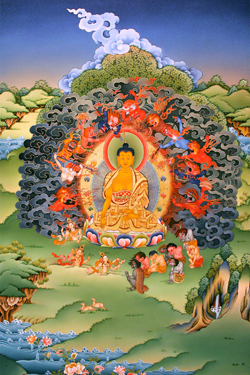 |
|
Panel Nine; The Conquest of Evils: While in meditation, as Siddhartha was focused with laser-like precision on the forces keeping humankind from a complete awakening, the demon Mara attempted to both seduce and distract Siddhartha. This is the overriding theme illustrated in Panel Nine. In Buddhist mythology, Mara attempts to seduce Siddhartha with visions of his beautiful daughters and apparitions of other demons. Mara is thus considered the personification of all forces impeding or standing in the way of enlightenment. As he attempted to disturb the meditation, Mara had the demons shoot arrows and throw spears, hurl fire, and distract him in any way possible. These are the actions illustrated in Panel Nine; yet Siddhartha remained undisturbed and undeterred. All the negative actions of his tormentors are conquered and he becomes surrounded by the Four Noble Truths and a protective Mandorla, or radiance. The Four Noble Truths, illustrated as jewels of green, red, blue and yellow in the Mandorla, lead the way to a full understanding of Buddhism and ultimately peace of mind through the conquering of Dukkha, the craving and clinging to impermanence. Jewel One represents Dukka itself; Jewel Two, the origin of Dukkha; Jewel Three, the cessation of Dukkha; and Jewel Four, the actual path to the cessation of Dukka, which is mindfulness and meditation. As Siddhartha continued his meditation, Mara abandoned his mission and Siddhartha shed the very last vestiges of ignorance and emerged as “Conqueror Buddha,” a fully enlightened being liberated from the endless cycle of birth and rebirth, which is illustrated in Panel Ten, Attainment of Buddhahood.
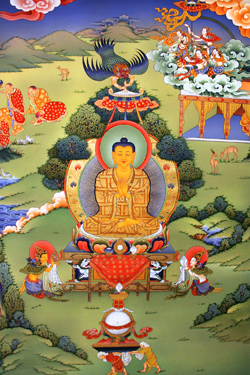 |
|
Panel Ten; Attainment of Buddhahood:In Panel Ten, we see Siddhartha as a fully enlightened being – as Buddha. Now he has been elevated onto a platform and offerings are being made. In the full story of Buddha, it is suggested he was hesitant to teach the Dharma, or path to others after his awakening; however, he was convinced to teach by Sahampati, an enlightened Brahman. Some elements to note in Panel Ten are the Garuda holding a canopy over Buddha and the heavenly angels rejoicing. Garuda is the mount of Vishnu, the protector of mankind; and as Vishnu’s mount he is able to fly anywhere to protect the salvation and manifest joy of humankind. Here he is shown shielding Buddha from anyone or anything that will prevent his truth from being known. Also of note is a symbol at the bottom rising up from a bowl of mountains being carried by devotees. This symbol is interpreted as a Kalasa, a vessel holding Amrit or the elixir of immortality. This symbol has also been interpreted as a spout less Bhumpa, a vessel containing the complete expanse of the universe. Either way, this symbol suggests that the only way to gain immortality is through breaking the cycle of birth and rebirth through the practice of the Middle Way. After his awakening, Buddha traveled to India to teach, and while there delivered his first sermon to the five former mendicants who had previously left him when he abandoned austerity in favor of the Middle Way. He continued to teach and gain followers, which is illustrated in Panel Eleven, Promulgating the Teachings.
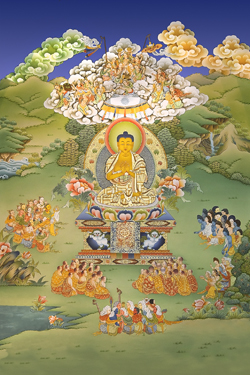 |
|
Panel Eleven; Promulgating the Teachings: Buddhist mythology suggests the original five mendicants who once abandoned Siddhartha became Arhats – holy men in their own right – following Buddha and forming the first Sangha, or Buddhist community. As time unfolded, the Sangha grew. This is the essence of Panel Eleven. Ultimately, the Sangha expanded and members traveled throughout the Indian sub-continent and the Himalayas expounding the Dharma, which can be simply interpreted as the teachings of the Buddha. It is said the original Sangha recorded the oral teachings of Buddha in the form of Sutras, discourses of various lengths. Panel Eleven shows the transmission of these teachings while a celestial choir rejoices above. It was the practice of Buddha's teachings that enabled one to break the cycle of birth and rebirth and enter Nirvana, which is illustrated in Panel Twelve, Buddha Entering Nirvana.
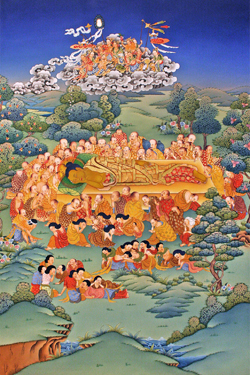 |
|
Panel Twelve; Buddha Entering Nirvana: According to the Sutras, Buddha announced at the age of 80, 45 years after his awakening that he would enter Paranirvana, which is a reference to the final deathless state, and is commonly used interchangeably with the word Nirvana, interpreted by many people as heaven. Panel Twelve illustrates Buddha in a reclining position as he transitions to Nirvana. Most people refer to depictions of this sort as Reclining Buddha, but the formal name of this panel is Buddha Entering Nirvana. Although his followers are depicted as grieving, Buddha is shown with a slight smile on his face, at peace, having accomplished what he came to do on earth, which is implied in Panel One. At the same time, a celestial choir rejoices above as in the preceding panel. Famously, at the time of his passing it is reported Buddha told his followers to follow no leader, but instead to follow the Middle Way to relieve all suffering.
Since its opening in 2006 the Buddha Room has been visited by many thousands of people, who we hope in one way or another have been inspired. Although the staff of PRIMITIVE is not composed of a group of devout Buddhists intent on evangelizing Buddhism, every member of the staff recognizes Buddha has transcended his role as a Buddhist deity and become an icon for peace and serenity, which means simply – one need not be Buddhist to have a Buddha in their home or garden. The room also references two other ideas: first, that the greatest form of wealth a person can attain is peace of mind; and second, that what is real is what we make real. Although the Buddha Room is technically a showroom, virtually everyone who visits treats it as sacred space. Consequently, as of this writing there have been 28 weddings in the Buddha Room as well as countless other events. In regard to the paintings found inside, Panel Twelve may be viewed as the ending; however, it is just as easy to view it as a beginning – the point at which Buddha’s teachings become fully realized and there is a complete cessation of suffering. Our hope, of course, is each person exposed to these paintings will achieve peace of mind.
Footnote: The Buddha room paintings are available as a boxed set of note cards. Printed on archival ink on acid free paper, they faithfully capture the details of the paintings in miniature. Give the set as a gift, use as note cards, or frame them as fine art. Study them, and they might even lead to peace of mind.